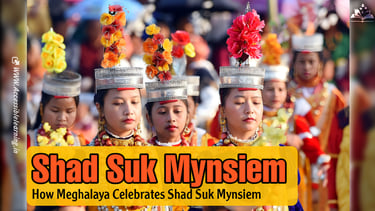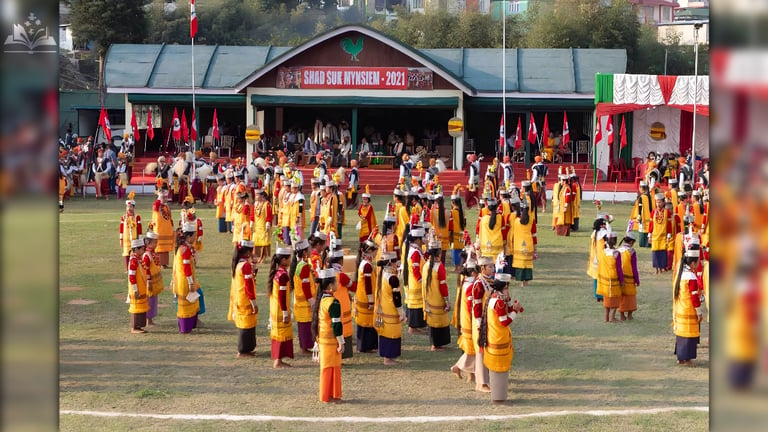
Shad Suk Mynsiem: Meghalaya’s Sacred Dance of Joy and Gratitude
Shad Suk Mynsiem, the vibrant Khasi spring festival of Meghalaya, is a sacred dance of gratitude, purity, and cultural preservation. Discover its deep-rooted traditions, spiritual significance, and mesmerizing celebrations in this insightful guide.
CULTURE/TRADITIONEVENT/SPECIALINDIA/BHARATCELEBRATION/FESTIVALS
Kim Shin
4/6/20253 min read


Shad Suk Mynsiem, which translates to "Dance of the Joyful Heart," is one of the most revered and vibrant festivals of Meghalaya, India. Celebrated annually by the Khasi tribe, this spring festival is a grand expression of gratitude, culture, and spiritual beliefs. Often likened to a "Thanksgiving Dance," Shad Suk Mynsiem signifies the harmony between nature, humanity, and the divine.
The Significance of Shad Suk Mynsiem
For the Khasi community, Shad Suk Mynsiem is not just a cultural event but a deep-rooted tradition symbolizing purity, fertility, and the divine blessings of Mother Nature. The festival is held in April, coinciding with the arrival of spring, a season of new beginnings and prosperity.
The festival is primarily dedicated to thanking the Almighty, known as "U Blei Nongthaw," for a fruitful harvest and the well-being of the people. It embodies the Khasi philosophy of life, which values peace, respect for nature, and the purity of body and soul.
The Rituals and Celebrations
Shad Suk Mynsiem is a three-day festival held at the Weiking Ground in Shillong, Meghalaya’s capital, and in various other locations across the Khasi Hills. The celebrations are characterized by traditional dance and music, performed with elaborate rituals and sacred practices.
The Traditional Dance
The dance is performed in a disciplined and symbolic manner, reflecting Khasi societal values:
Male dancers, dressed in regal golden silk dhotis, turbans, and silver ornaments, represent warriors, protectors, and the strength of the community.
Female dancers, dressed in exquisite silk attire with intricate jewelry, embody purity, grace, and fertility.
The dance is performed in a circle, symbolizing the unity of the community and the cosmic balance of life.
The dancers move with synchronized steps, guided by the rhythmic beats of traditional instruments, creating an enchanting spectacle for spectators.
The Role of Music
Live traditional music played on drums (Ka Ksing), flutes (Ka Tangmuri), and other indigenous instruments accompanies the dance, setting a rhythmic and sacred tone for the celebration. The music is believed to invoke blessings and ensure the prosperity of the Khasi people.
The Spiritual Connection
Unlike other Indian festivals, Shad Suk Mynsiem is deeply spiritual and has no commercial elements. Only unmarried Khasi girls participate in the dance, representing purity and the blessings of womanhood, while men perform to symbolize the protection and preservation of culture.
Traditional Attire and Ornaments
The festival showcases elaborate traditional Khasi attire, with intricate detailing that reflects the community’s rich heritage. Men wear turbans, gold and silver jewelry, and embroidered coats, while women adorn themselves in vibrant silk wraps, elegant shawls, and exquisite silver accessories.


Why Shad Suk Mynsiem is Important Today
Preserving Khasi Identity: The festival plays a crucial role in maintaining the indigenous Khasi traditions and reinforcing the community’s values in a rapidly modernizing world.
A Message of Harmony: The celebration is not just about dancing; it reflects the Khasi way of life—one that respects nature, community, and spirituality.
Tourism and Cultural Awareness: Shad Suk Mynsiem attracts visitors from across India and beyond, offering a glimpse into the rich cultural tapestry of Meghalaya.
A Symbol of Womanhood: The festival highlights the Khasi matrilineal system, where women are highly respected and considered the bearers of tradition and heritage.
A Connection to Ancestral Roots: The festival reinforces the values passed down from ancestors, ensuring that younger generations stay connected to their roots despite modern influences.
Promoting Community Unity: The collective participation in the festival strengthens community bonds, fostering a spirit of togetherness and mutual respect.
How to Experience Shad Suk Mynsiem
If you wish to witness this mesmerizing festival, plan your visit to Shillong in mid-April. The best way to experience it is by visiting the Weiking Ground, where the main celebrations take place. Observers are encouraged to respect the cultural sanctity of the event and enjoy the performances with reverence.
Additionally, local homestays and guided cultural tours provide an immersive experience, allowing visitors to learn about Khasi customs, folklore, and traditional cuisine.
Shad Suk Mynsiem is more than just a festival; it is a living testimony to the Khasi way of life, spirituality, and deep connection with nature. In a world where traditions are fast fading, this age-old celebration continues to shine as a beacon of cultural pride and unity. Whether you are a cultural enthusiast, a traveler, or someone who appreciates rich traditions, experiencing Shad Suk Mynsiem will leave you with a joyful heart and a deeper understanding of Meghalaya’s heritage.
Subscribe To Our Newsletter
All © Copyright reserved by Accessible-Learning Hub
| Terms & Conditions
Knowledge is power. Learn with Us. 📚


